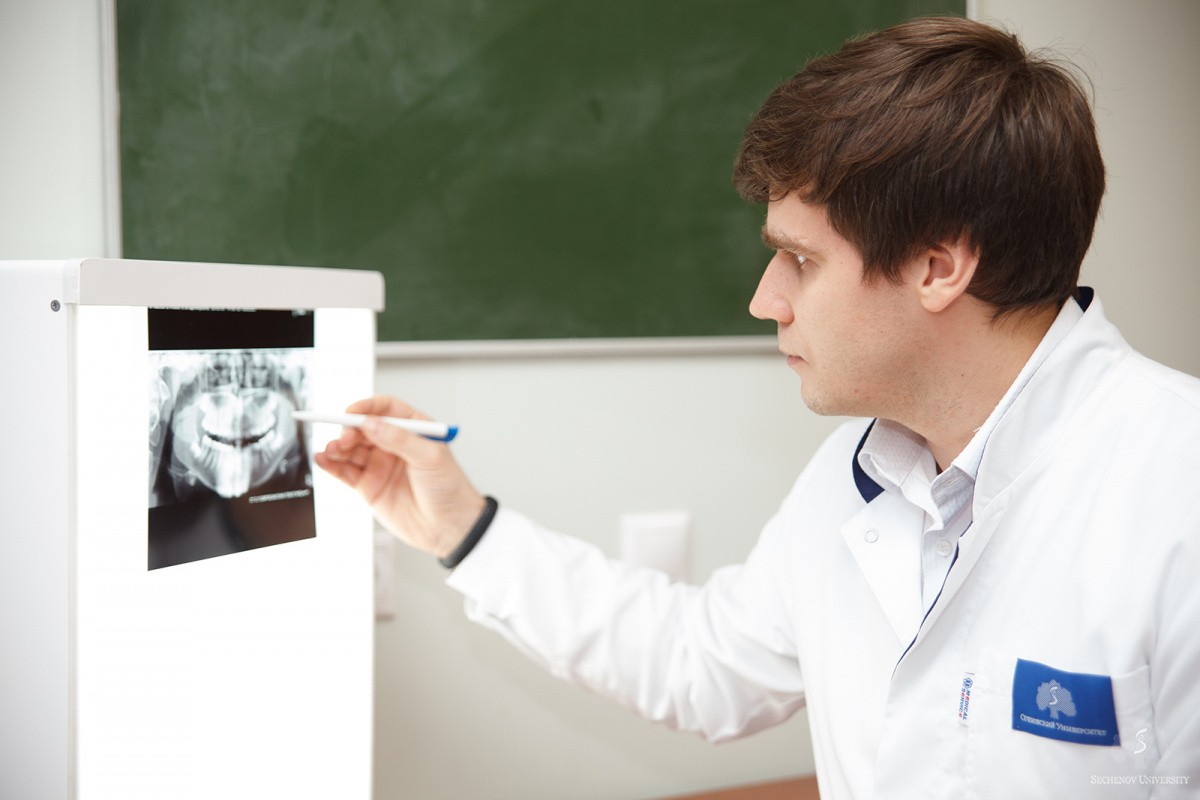-
About University
- Mission & Brand Strategy
- University Leadership
- Rector's Welcome
- History
- Regulatory Documents
- Contacts
- Staff
- International Recruitment
- Partners
Applicants- Why Sechenov University
- Degree Programmes in English
- Preparatory Training
- Non-Degree Programmes
- Transfer from other Institutions
- FAQs
11.08.2020Bovine teeth are used as model of bacterial infection in humans
 Infections of the root canal and the dentine are very painful. Despite the current treatment options, not much is known about how effective the medicines can be. Sechenov researchers investigated the factors that could play a role in infection and suggested a model for the analysis of bacterial growth.
Infections of the root canal and the dentine are very painful. Despite the current treatment options, not much is known about how effective the medicines can be. Sechenov researchers investigated the factors that could play a role in infection and suggested a model for the analysis of bacterial growth.
Most people do not like going to a dentist, but sometimes it is the only thing to do. If you are unlucky enough to get a bacterial infection of the root canal, you will experience pain when consuming hot or cold food and beverages. Eventually, you can get gum swelling near the affected tooth. Treatment of the root canal infection involves removal of bacteria during a procedure called endodontics. It is also known that microorganisms can penetrate into the dentine — underneath the enamel. In this case, not much is understood about how effective various medications are against such deep infections. Sechenov University dentists performed a laboratory study aiming to investigate bacterial penetration into the dentine. The results have been published in Archives of Oral Biology.
The researchers used 22 deciduous (temporary) and 22 permanent bovine teeth for this study. They prepared 88 semi-cylindrical specimens, removed the smear layer, and sterilised the teeth. The scientists used bacteria Enterococcus faecalis to create tooth infection. Different protocols of inoculation were used: incubation with bacteria for 1 day or 14 days; stationary incubation of the specimens or centrifugation with bacterial cultures; and all combinations — for deciduous and permanent teeth. Randomly chosen specimens from each group were taken for bacterial culturing of dentine shavings. Colony-forming units were counted in each case to evaluate the number of bacteria. In addition, the researchers looked at the depth, density, and uniformity of bacterial penetration by scanning electron microscopy and confocal laser scanning microscopy.
There were more intratubular bacteria (and they penetrated deeper) in the specimens that had been inoculated with centrifuged cultures for 1 day, compared with the samples without centrifugation. In the case of a 14-day inoculation, dentine infection was more pronounced in deciduous teeth than in permanent, regardless of the other factors. No bacterial biofilm was detected on the root canal wall after 1-day inoculation; however, the biofilm was found on all specimens after 14-day inoculation. These results clearly show that centrifuged cultures that imitate exposure to greater bacterial numbers, cause a more severe infection. In addition, prolonged exposure affects temporary teeth worse. However, bacteria need some time to form a strong biofilm on the teeth.
The authors conclude that an ideal model, which could be used for the in vitro assessment of endodontic irrigants and intracanal medications, should present a deep dentine infection and a mature biofilm. For future experiments, they recommend using deciduous teeth. The authors hope that their findings will help establish a protocol that might be useful for dentists who need to analyse tooth infection and possible treatment methods.
This work was performed by the Institute of Dentistry (Sechenov University) together with Martsinovsky Institute of Medical Parasitology and Tropical Medicine (Sechenov University) and the Department of Biology at Lomonosov Moscow State University.
Read more: Dezhurko-Korol VA, et al. The influence of centrifugation and inoculation time on the number, distribution, and viability of intratubular bacteria and surface biofilm in deciduous and permanent bovine dentin. Arch. Oral Biol. (2020).Embed on website
Bovine teeth are used as model of bacterial infection in humans
Infections of the root canal and the dentine are very painful. Despite the current treatment options, not much is known about how effective the medicines can be. Sechenov researchers investigated the factors that could play a role in infection and suggested a model for the analysis of bacterial growth.
Most people do not like going to a dentist, but sometimes it is the only thing to do. If you are unlucky enough to get a bacterial infection of the root canal, you will experience pain when consuming hot or cold food and beverages. Eventually, you can get gum swelling near the affected tooth. Treatment of the root canal infection involves removal of bacteria during a procedure called endodontics. It is also known that microorganisms can penetrate into the dentine — underneath the enamel. In this case, not much is understood about how effective various medications are against such deep infections. Sechenov University dentists performed a laboratory study aiming to investigate bacterial penetration into the dentine. The results have been published in Archives of Oral Biology.
The researchers used 22 deciduous (temporary) and 22 permanent bovine teeth for this study. They prepared 88 semi-cylindrical specimens, removed the smear layer, and sterilised the teeth. The scientists used bacteria Enterococcus faecalis to create tooth infection. Different protocols of inoculation were used: incubation with bacteria for 1 day or 14 days; stationary incubation of the specimens or centrifugation with bacterial cultures; and all combinations — for deciduous and permanent teeth. Randomly chosen specimens from each group were taken for bacterial culturing of dentine shavings. Colony-forming units were counted in each case to evaluate the number of bacteria. In addition, the researchers looked at the depth, density, and uniformity of bacterial penetration by scanning electron microscopy and confocal laser scanning microscopy.
There were more intratubular bacteria (and they penetrated deeper) in the specimens that had been inoculated with centrifuged cultures for 1 day, compared with the samples without centrifugation. In the case of a 14-day inoculation, dentine infection was more pronounced in deciduous teeth than in permanent, regardless of the other factors. No bacterial biofilm was detected on the root canal wall after 1-day inoculation; however, the biofilm was found on all specimens after 14-day inoculation. These results clearly show that centrifuged cultures that imitate exposure to greater bacterial numbers, cause a more severe infection. In addition, prolonged exposure affects temporary teeth worse. However, bacteria need some time to form a strong biofilm on the teeth.
The authors conclude that an ideal model, which could be used for the in vitro assessment of endodontic irrigants and intracanal medications, should present a deep dentine infection and a mature biofilm. For future experiments, they recommend using deciduous teeth. The authors hope that their findings will help establish a protocol that might be useful for dentists who need to analyse tooth infection and possible treatment methods.
This work was performed by the Institute of Dentistry (Sechenov University) together with Martsinovsky Institute of Medical Parasitology and Tropical Medicine (Sechenov University) and the Department of Biology at Lomonosov Moscow State University.
Read more: Dezhurko-Korol VA, et al. The influence of centrifugation and inoculation time on the number, distribution, and viability of intratubular bacteria and surface biofilm in deciduous and permanent bovine dentin. Arch. Oral Biol. (2020).



